Novia Scotia
Halifax
We proceeded up the coast to the town of Halifax Novia Scotia.
Halifax, other than being a shipping center for the region, is known for three things:
- Graveyard for a number of the Titanic victims. Including one J. Dawson. Unfortunately, that was Joesph Dawson, not Jack Dawson.
- The Citadel – Which is an old base for the British Troops stationed in Novia Scotia
- Lastly, but certainly not least, Novia Scotia is famous for blowing itself up once.
The Citadel was quite interesting, with intelligent young docents dressed in period correct military costumes and quite miserable in the heat in those costumes. The barracks and living quarters were re-created and they actually fired a real cannon at noon.

One interesting point made was that the Crown got a lot of its soldiers from the poor and uneducated, and offered those people, in addition to regular meals, a chance at education through the school that was within the Citadel.
We also went to the Titanic Graveyard. The dead from the Titanic were offloaded from the recovery ships (notably not the SS. Californian) and identification was attempted. If the identification was successful and the family of the victim had the means to pay the body was returned. Those that were unidentified or whose families were unable to pay (the White Star line refused to pay) for repatriation, were buried in Halifax.
The graves are lined up in the shape of the bow of the ship – according to our guide in the same dimensions as the Titanic.
We also went into the Maritime Museum there. There we saw artifacts from the Titanic and learned about the great explosion that nearly destroyed Halifax in 1917. Wikipedia does a fine job of explaining the cause and effect of the explosion, so I won’t discuss sit here, except to mention that it reminded me a bit of my own family history and the explosion at Texas City.
Ferry
After Halifax we spent the night in the Arm of Gold campground – a very fine campground that has the distinction of being a mere 3 1/2 miles from the Ferry to Newfoundland.
The ferry was larger than other ferries we had been on, with multiple vehicle and passenger decks. We were force to leave our dog ginger in the RV on vehicle deck 3 and go up to the passenger decks. We were not permitted to remain in the RV with Ginger. Though we would learn later that truck drivers often slept in their sleepers during the transit.
The passenger decks were very nice with cafeteria style food available – not exactly gourmet cuisine – but what do you expect from a ferry? The seats were comfortable and many of our party took naps during the 6&1/2 hour transit to Newfoundland.
As we approached Newfoundland, we returned to the RV and found that Ginger had been asleep the entire time and was not the slightest bit traumatized.
Newfoundland
Southern Newfoundland – Doyles
We went to our first Newfoundland campground, a mere 24 miles from the ferry terminal in Doyles. This was a very nice place called Grand Codroy. This was a partial hookup campground (no sewer), but very pretty along the Codroy river.
The group took a guided tour to see what passed for sightseeing sites in Doyles. The tour was memorable because of the tour guide who was a local – owned the Grand Codroy campground and was quite the local gossip. We saw the infamous “Newfie Bullet” – the train that ran the length of Newfoundland at embarrassing slow speeds.
Alas, the Newfie Bullet runs no more.
We got our first taste of lack of internet on Newfoundland. We found the best we could get was marginal LTE (Less than Excellent) cellphone coverage which was still better than the overloaded WIFI at the campground. It kind of precluded updating this blog, much to the dismay of both of my readers.
The Cod Crash
You shouldn’t talk about Newfoundland unless you mention the Cod Moratorium.
July 2, 1992 is a date with which all Newfoundlanders (don’t call them Newfies) are familiar. This is the day the Canadian government announced it was closing the cod fishing grounds on the Grand Banks due to overfishing and the potential extinction of the Atlantic Cod.
In one fell swoop, the government closure cost over 34,000 Newfoundlanders their jobs and their way of life. To this day the cod stocks have not recovered to a level that permits other than very limited and restricted fishing of cod on the Grand Banks.
Many small towns in Newfoundland lost their fishing boats, packing plants eventually the towns itself as the people of Newfoundland scrambled to find other ways to make a living often away from their home island. Many of the people were older, working at jobs they had all their lives, in their 50’s and 60’s, were told by the Government they had to retrain.
The mantra became “Retrain?? For what?”
We would pass though coves on the coast where the only thing remaining of the town were some foundations and a concrete slab where the packing plant stood. A couple of the smaller surviving towns converted their packing plant to skate board parks for the local kids.
The province continues to this day to lose population.
Some cod fishing is permitted in the Barents sea and the Gulf of St. Lawarence, but while we there the Canadian Government announced that the Gulf of St. Lawarence fishery was to close indefinitely.
None of the Newfoundlanders I talked to questioned the need to shutdown the cod fishing – the catch had been deteriorating sharply over the last few years. They questioned the Government actions during and after the shutdown.
The fisherfolk in Alaska going after salmon should take heed and warning. It may be too late already….
The Journey North
From Doyles we continued north at a fairly rapid pace northward. The caravan we were in, didn’t like to drive for large amounts of hours (a sentiment we heartily agreed with) so our longest driving stint was 285 miles. Along the way, we stayed in a wonderful, though primitive RV park operated by the Lions club in Port Au Choix. This park was along the rock oceanfront and had incredible views.
Along the way we became familiar with what is known as the Newfie Shimmy. The shimmy is due to the fact that the roads in Newfoundland are quite bad, despite valiant efforts by their highway department. This leads to cars and truck weaving all over the road, center striping and even driving on the left. We were assured by the Newfoundlanders that this was expected behavior and would not cause the Mounties to pull you over for drunken driving. Indeed we were told that if you drive in straight line, you might get pulled over because the Mounties would want to know what’s wrong with you. There is a joke in Newfoundland that “In England you drive on the left side of the road, in Newfoundland, you drive on what’s left of the road“.
We also found a large number of gardens along the road. These were sort of protected from the moose by makeshift fences. It turns out that the soil in Newfoundland is quite sparse and the construction of the road turned up quite a bit of new soil that Newfoundlanders used to grow vegetables.
There was also large piles of firewood along the road. Newfoundlanders will go onto the crown land, cut the wood and set it along side the road to season for a year or two. They put their names on the pile and trust that no one will steal their wood.
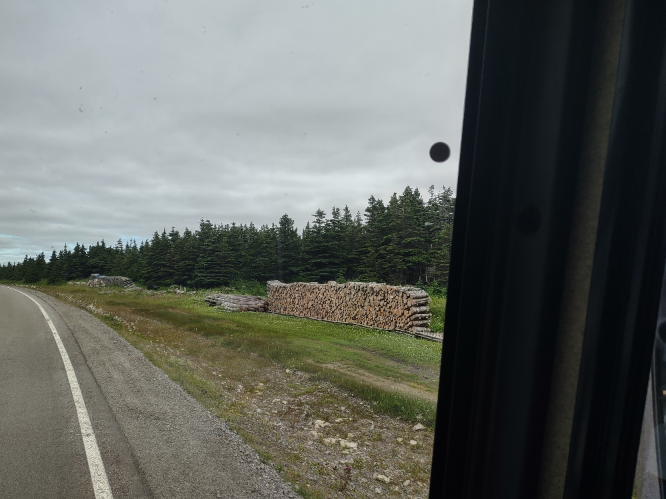
They apparently don’t worry too much about theft. Their gas stations have you fill up and then pay – no need to leave a credit card with the attendant.
Another 190 miles later we ended up in St. Lunaire-Griguet in the Viking RV Park. This was just outside of St. Anthonys and about as far north as you can get on Newfoundland island.
St. Lunaire-Griguet is on what is known as the Viking Trail. In addition to spectacular scenery, incredible wildlife and some of the nicest people in the world, the top of Newfoundland was apparently the location of the Viking settlement in America. Or rather the first settlement in the Americas.
In the 11th century, well ahead of that misguided Italian that mistook the Caribbean for the Indies, Lief Ericsson established an outpost on the north end of what we now know as Newfoundland. This tiny outpost served as a trading post and a base for further explorations.
The outpost was burned and abandoned after some years for reasons unknown. The outpost remained lost until the early 1960s when some archeologists were told by some the local fisherman about the “old Indian Village” on the outskirts of town. The site was excavated and the lost Viking outpost was re-discovered. It became known as L’Anse aux Meadows.
We toured the excavation site, viewed some of the recovered artifacts and visited a replica Viking village that was nearby. This was in addition to coast watching, fishing village exploration and being presented with two gratis cod fish by some commercial fishermen with whom we had stopped to chat.
The Journey South – Gros Morne
After enjoying the food music and beer of St Anthonys, we started to retrace our steps south. Our first stop after 230 miles was Gros Morne National Park.
Gros Morne is named after a large mountain nearby, but includes coastal and intertidal areas a well. The town of Rocky Harbor is included within the park. There are lots of food, dining and accommodations within Rocky Harbor.
While we were there, we took a fascinating boat ride on a freshwater pond a few miles out of town. This boat ride took us up in the Fjords of Gros Morn with sheer granite cliffs rising more that 2000 feet above the crystal pure water.
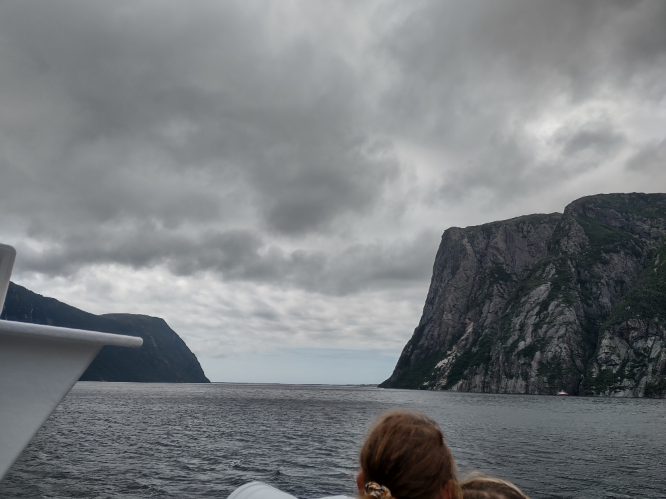
We also took a boat ride in Rocky Harbor itself. Once again the effects of the cod moratorium were evident in the small towns in the coves along the coast. We saw the spectacular cliffs and beaches that the area is famous for.
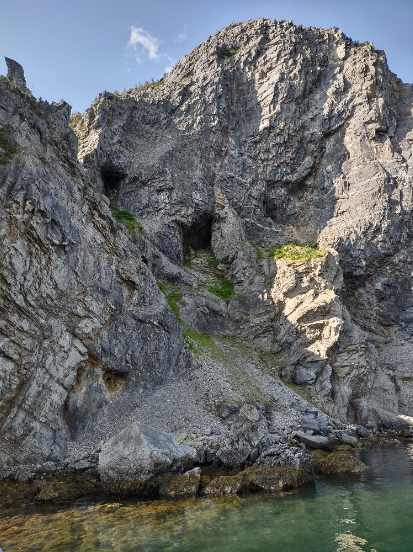
From Gros Morne we travelled back to Grand Codroy in Doyles. After a night of multiple shots of rum our entire caravan were adopted as honorary Newfoundlanders.
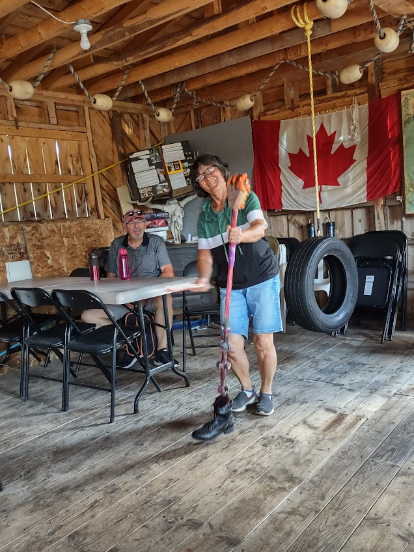
They have a musical instrument that is unique to Newfoundland. It is a stick in a boot with beer caps nailed to the stick as cymbals and some kind of topper. This stick is banged on the floor in time the music. We saw it several times in Newfoundland.
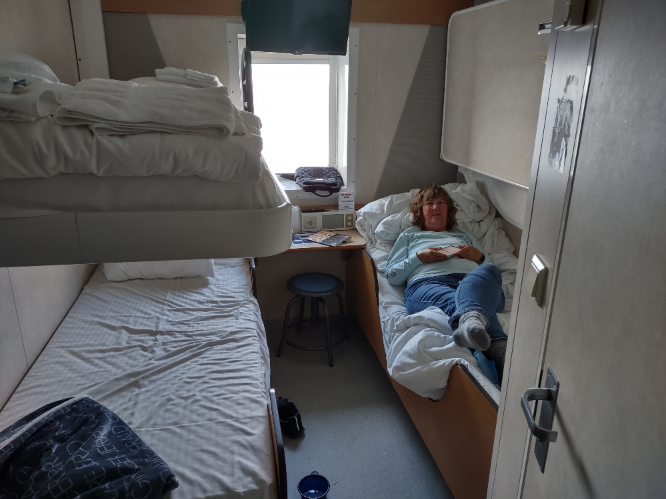
We then took the ferry back to Nova Scotia. This time we rented a dog-friendly cabin on the Ferry. So Ginger, Claire and I took a 6 hour nap during the ferry ride.
Prince Edward Island
We returned briefly to Nova Scotia, making the mandatory stop at the Insectarium and then set out for Prince Edward Island. Until fairly recently Prince Edward Island was only accessible by ferry, but a long bridge was finally constructed from Nova Scotia to the island. It is a toll bridge, but there is only a toll to get off the island. We surmised that they wanted our money first. The toll is quite steep – $50.00 for the first two axles and $9.00 for each axle afterwards. We found out that the Confederation Bridge was built by a company that will be allowed to collect tolls until the bridge is paid for, at which time the bridge will revert to the government.
We ended up in a RV park called Marco Polo Land, which was named after a ship that had floundered on the nearby rocks. This place was a kids paradise: Multiple bounce bubbles, a waterpark with a large pirate ship and multiple water slides., lots of playgrounds etc.
But there were no kids on our caravan.
We went out to the civic center, Charlottetown, one night and saw a play called “Telltale Harbour”. This was a story about a small fishing village trying to repurpose itself (remember the cod moratorium) as a french fry factory (PEI is right behind Idaho in potato growing). While the play was clearly had local themes, it was quite funny poking fun at the British as well as the locals. One of the musical numbers was “Cricket sucks, Hockey rocks”. It was quite enjoyable with a very good cast.
We took a tour the next day and learned about the potato industry PEI, how all the rocks they use in erosion mitigation along the coast are imported – apparently there are no large rocks on PEI, learned about the local history and the history of Anne of Green Gables.
Anne of Green Gables is a series of books written by Lucy Montgomery in the early 1900 about a orphan girl that is adopted by an older brother and sister and lived on Green Gables farm on Prince Edward Island. They were and remain enormously popular to this day.
The farm that was the inspiration for Green Gables farm has been preserved by the province and opened to the public as a museum to the fictional Anne and Lucy Montgomery (who is buried nearby).
The tour guide was quite disappointed that none of the people in the caravan were big Anne fans.
The next day was the last day of the caravan. They fed us breakfast and we hugged our new friends, flicked a tear from our eyes and headed off of Prince Edward Island for New Brunswick.
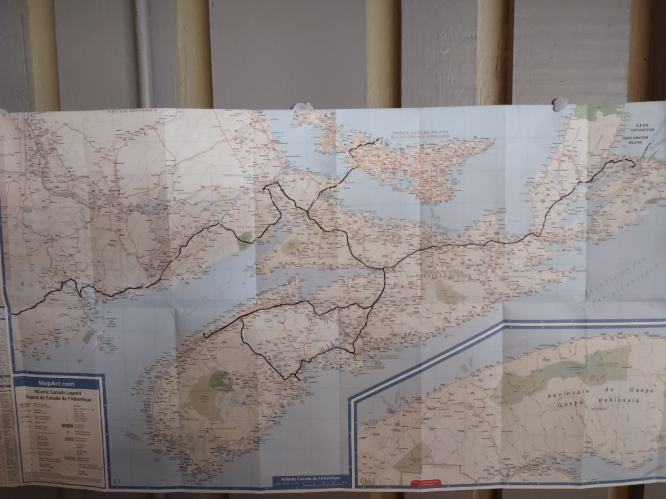
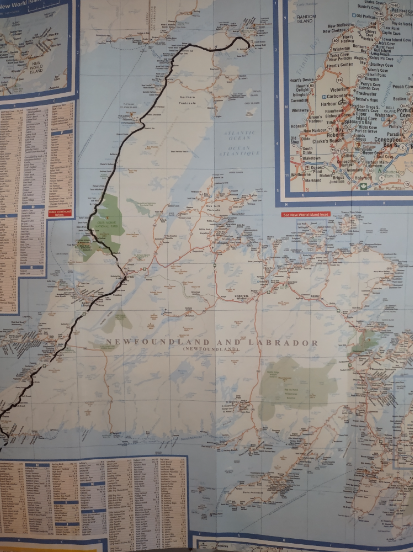
We enjoyed the dickens out of this Caravan. The people, the Wagonmasters, the Tailgunners were all exquisite. We will be doing other Fantasy RV tours.
And Exit…
We were so taken with Canada we tarried a bit in New Brunswick, moving to an RV park on Deer Island and then to a regional park on Campobello island – home of the FDR vacation home, eventually reentering the United States through Lebec Maine.
